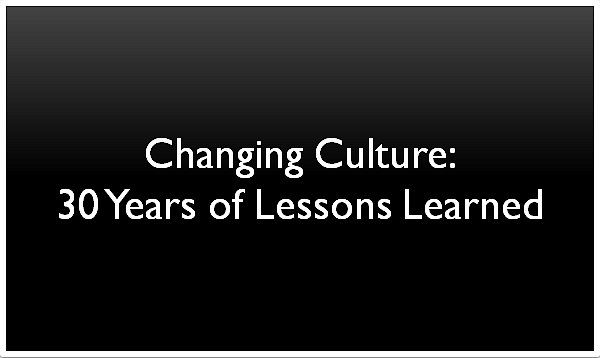Additional Problems with the Use of Benchmarks
Additional Problems with the Use of Benchmarks
Effective Cultures are Contextually Appropriate
An organization’s performance is affected by the extent its culture is contextually appropriate and aligned to strategy. A contextually appropriate culture acknowledges the importance of industry, but also reflects market dynamics, societal values, leadership, organization size, life cycle stage, governance structure, M&A history and other factors in determining norms, values and beliefs.
Societal values, for instance, have a greater influence on culture than industry norms. This means there is no such thing as a global, industry-specific culture.
It also recognizes the critical role that culture plays in enabling strategy execution and in turn, the effect that strategy has on cultural norms and behaviors. While organizations in the same industry may have some cultural attributes in common, differing strategies mean their cultures are distinctive in other significant ways. For example, all companies in the regulated airline industry require a normative culture due to the importance of safety and reliability of operations.
However, companies such as Frontier Airlines and Spirit compete on price, which requires a culture that emphasizes consistency and efficiency of operations evident in a strong process and task orientation. At the same time, Emirates and Singapore Airlines have built their brand on the promise of a special, consumer experience. This is achieved, in large part, by providing a personal touch in every customer interaction, which requires a high engagement culture that is people-oriented, flexible and adaptive.
Similarly, an organization that strives to differentiate itself from competitors through product innovation requires a different culture than one that aims for excellence in the customer experience or reliability of its operations.
Culture Benchmarks Reinforce the Status Quo
Organizations that have the good fortune to operate in a stable environment don’t have to worry about changing their culture. As long as they continue to perform and achieve their goals, the culture can and will remain unchanged. For an organization to thrive, and even survive, in a dynamic environment, it must be adaptive; able to anticipate and respond effectively to change on a continual basis.
Emerging technologies, the entrance of new and/or non-traditional competitors, shifts in customer expectations and other evolving market dynamics demand new and different ways of thinking and operating.
In many cases, the assumptions and beliefs that once helped the organization succeed become barriers to progress and change. As a result, the culture an organization has today is unlikely to be what it needs for the future. In these environments, comparisons to others in the same industry add little if any value.
In fact, instead of helping to improve performance, benchmarks create the risk of perpetuating the status quo and in so doing undermine efforts to adapt and change. If evidence is needed, look no further than popular management books such as Bossidy, Charan and Burck’s (2002) Execution and Collins’ (2001) Good to Great. Many of the organizations cited as examples of the cultures that others should aspire to, ended up struggling or outright failing.
Culture is Dynamic and Systemic
Organizations are living systems in that all of their elements are interconnected and work together to fulfill their purpose and mission. Culture affects and is affected by strategy, structure, policies, processes, physical space and so on. Cultural attributes cannot be viewed as separate components operating in isolation of each other or other elements of the broader system.
It is the rich combination of all of the cultural attributes, and other elements of the system, working together in a dynamic and organic manner that makes each and every organization’s culture unique.
This is what makes culture so “sticky”. It is embedded in all aspects of the organization system. Yet, industry benchmarks by design treat cultural attributes as independent variables. This can lead to actions to close the gap on a specific attribute, without considering its connectedness to other aspects of the culture or the organization system as a whole. The result is unintended and potentially detrimental consequences impacting culture and performance.
Let’s say, for example, an organization discovers it is below the industry benchmark on process-orientation (emphasis on how work gets done). As a result, an action plan is developed to document core work processes, eliminate exceptions, simplify work and implement a disciplined approach to process change management.
However, for decades, employees have been taught that processes are bureaucratic encumbrances impeding delivery of the customer experience. This is firmly entrenched in the organization’s belief system and is evident in the way people work and interact. For the process improvement initiative to be successful, it must reconcile this conflict in an explicit way that is embraced by the organization.
This includes looking at the culture holistically and addressing competing norms such as tendencies for groups to work in isolation and to allow people to deviate from the standard process. If this does not happen, it is highly unlikely that change efforts will be successful or sustained.
Closing Thoughts
An assumption implicit in the use of industry benchmarks is the premise that organizations should strive to develop a culture that is similar to that of others within the industry. But what if an organization is striving to be different and stand out from its competitors or there is a new entrant with a different paradigm about the way to do things? If culture is truly a potential source of differentiation, what is the value in being the same as every other organization in the industry? Does Uber desire to have the same culture as a traditional taxi or limousine company?
Instead of asking how our culture compares to others in our industry, there are two questions leaders should ask:
- Do we have the culture we need to execute our strategy, achieve our goals and fulfill our purpose?
- Do we have an adaptive culture that allows us to anticipate and respond effectively to change?
A culture assessment can help leaders answer these questions by providing a common language and frame of reference to anchor discussions. It can also reveal culture strengths which can lead to insights regarding the organization’s deeply embedded belief system. It should not circumvent the dialogue required to build shared understanding and alignment that leads to meaningful action which is a very real danger inherent in the use of industry benchmarks.
CultureStrategyFit can work with you. When you want to quantify your culture, contact us.










